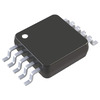Manufacturer Part Number
MAX16930BATLW/V+T
Manufacturer
Analog Devices
Introduction
High-efficiency, automotive-grade Power Management IC with step-up and step-down capabilities
Product Features and Performance
Integrated Transistor Driver
Buck-Boost Topology
Synchronous Rectification for Improved Efficiency
Frequency Synchronization Capability
Multiple Output Configurations Supporting Three Outputs
Two Output Phases for Reduced Ripple
High Switching Frequency Range of 1MHz to 2.2MHz Allowing Small Inductors and Capacitors
High Duty Cycle up to 95% for Lower Dropout Operations
Operates Across a Wide Input Voltage Range from 3.5V to 42V
Product Advantages
Designed for Automotive Applications
High Efficiency Reduces Thermal Load
Flexible Power Solution for Varying Input Voltages
Extended Operating Temperature Range Suitable for Harsh Environments
AEC-Q100 Qualified for Automotive Reliability
Compact 40-WFQFN Package Saves Space
Key Technical Parameters
Number of Outputs: 3
Output Phases: 2
Voltage - Supply (Vcc/Vdd): 3.5V ~ 42V
Frequency - Switching: 1MHz ~ 2.2MHz
Duty Cycle (Max): 95%
Operating Temperature: -40°C ~ 125°C (TJ)
Quality and Safety Features
Automotive Grade Quality
Qualification: AEC-Q100
Compatibility
Surface Mount Technology for PCB Assembly
40-WFQFN Exposed Pad for Thermal Management
Application Areas
Automotive Power Systems
Power Management for Infotainment Systems, Advanced Driver-Assistance Systems (ADAS), and Body Electronics
Product Lifecycle
Active Status
Ongoing Support with No Near Discontinuation
Availability of Replacements or Upgrades Not Provided
Key Reasons to Choose This Product
Efficient Power Conversion for Automotive Applications
Support for a Wide Range of Input Voltages Increasing Design Flexibility
High Frequency Operation Minimizes Passive Component Sizes
Robust Thermal Performance Ensuring Reliability in Automotive Operating Conditions
AEC-Q100 Certification Guaranteeing Automotive Industry Standards Compliance
Multi-output Capability with High Efficiency Suits Complex Automotive Power Requirements



 MAX1692EUB+Analog Devices Inc./Maxim IntegratedIC REG BUCK ADJ 600MA 10UMAX
MAX1692EUB+Analog Devices Inc./Maxim IntegratedIC REG BUCK ADJ 600MA 10UMAX MAX16932ATIR/V+Analog Devices Inc./Maxim IntegratedIC REG CTRLR BUCK 28TQFN
MAX16932ATIR/V+Analog Devices Inc./Maxim IntegratedIC REG CTRLR BUCK 28TQFN